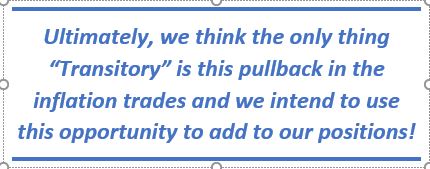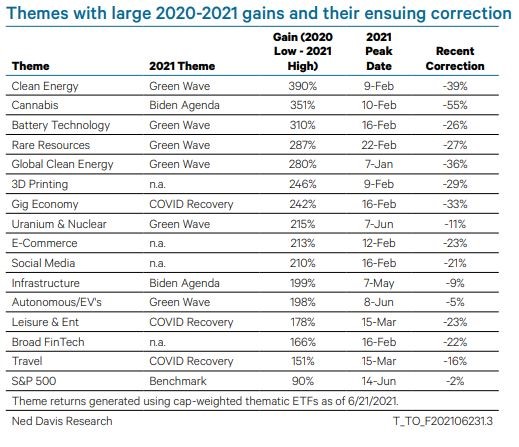There are all sorts of quips about investors and market trends. One that comes to mind now is that bull markets try to shake bull riders (investors). Another classic is that bull markets climb a wall of worry. The last three weeks has been a clear example of both. Our investment thesis and conviction has not changed one bit. We remain fully invested and raging bulls on the Reflation, Reversion and Recovery themes despite the market’s attempt to create doubt in all.
Reflation, Reversion and Recovery
These trends are nothing new to regular readers but we did a specific post regarding this idea last February which you can read again here https://allseasonfunds.com/reflation-reversion-and-recovery/ . Let’s spend a little time with each just to reiterate what we’re seeing and to what degree these themes have evolved since then.
First Reflation. This is now clearly INFLATION, not just reflation. This theme was initiated in October of 2020 and remains very strong, actually accelerating with the most recent print of 5% in the Consumer Price Index. That number is understating reality as we’ve discussed for years. Anyone who is spending money these days knows that rents, healthcare, gasoline, food, college tuitions, restaurants, and leisure, airfare, construction materials, housing, vehicles, etc. are up way, way, way, more than 5% year over year. Shadow stats says 9% now. That seems right to me. Regardless, there are three changes that have occurred on the inflation front since February. The first is that inflation measures are much higher than anyone expected at this time. The second is that wage pressure and labor costs have gone much higher since February as employers are having to pay up to find anyone. Last week I went to Qdoba for a burrito. There was a handwritten sign on the door.
“Closed – No workers”.
This is Qdoba! Wow. How much might it cost Qdoba in lost revenue when they must close their store because they simply can’t find unskilled labor (at any wage!).
Finally, we heard from Fed Chief Jerome Powell, that inflation is still transitory, under control, but running higher than expected. At the same time, he said they were not going to be raising interest rates anytime until 2023 while purchasing over $198B in Treasury and mortgage-backed securities in the last four weeks alone. Clearly, they are working very hard to keep rates low with talk and action. Score one for the Fed as the market bought the story. Inflation trades (Gold, Silver, Commodities, hard assets, industrials and materials) were sold off by almost 12% in three short days while bonds and the US Dollar were bid up.
What?
This is clearly the bull market (in the inflation trades) trying to buck the bull rider, nothing else. Inflation is not transitory and inflation is likely to run very hot for the foreseeable future. Remember, the Fed is boxed into a corner and has no choice but to continue talking down inflation. They know that any hint of pulling back on monetary easing will directly affect financial assets negatively and could quickly drive the economy into recession. They are clearly accepting high inflation over recession given the fact that global economies are still recovering from the pandemic. For now, the inflation trade is under a bit of pressure and may remain so for several more weeks. Ultimately, we think the only thing “transitory” is this pullback in the inflation trades and we intend to use this opportunity to add to our positions! Most of our strategies gave up a little ground in the last couple weeks; No surprise and no worry. We accept that as part of sticking with our conviction. Historically, big inflationary cycles have lasted 5-6 years. We are just 8 months in at this point.

The Reversion trend we spoke of in February was contextually about Value over Growth and Internationals over domestic securities. Here again we see nothing to indicate either trend has failed as much as just taking a mid-summer nap. Technology and growth are having a little resurgent moment in the last few weeks but this move still appears to be a “Trade” and not the primary “Trend”. We talked specifically about how technology and the growth side of the market will periodically offer a nice trade in this update – https://allseasonfunds.com/trends-versus-trade/. This is one of those times but It’s just a trade. Valuations for growth and technology are still absurd and it’s going to take a full-blown bear market to bring them back to a reasonable long-term level. When technology as a percent of the S&P 500 index is less than 15%, you can feel free to load up. Current, it still stands at 23% of the index. The value side of the market represented by energy, financials and select industrials are doing just fine still. Energy made an all-time new high on Friday, while financials and industrials are down less than 2% from their highs. We are sticking with an overweight position in stocks, specifically value and internationals /emerging markets and holding an underweight position in domestic large cap growth. Nothing has changed.
On the Recovery front, it’s pretty safe to say that we are now in a very robust global economic recovery period and moving toward expansion even beyond the highest levels set in 2019. Internationals offer the best growth potential still and are looking attractive again. Last year the market got ahead of the economy especially in some of the leading next generation, infrastructure, Green Wave, and “Biden Agenda” sectors. Ned Davis Research did some excellent work on the price action in these themes in a recent report. Many of the hottest sectors of last year peaked between Feb and May of 2021 and have corrected back to what could be very attractive levels as of mid-June. Take a look at this chart from NDR. If you believe in the recovery trend and you’re looking to buy the dips, this makes for a good shopping list of sectors to consider. As usual, set stops on any new buys and live by them.

As a side note, the list above represents a majority of the investment sectors within our long-standing New Power strategy. New Power finished up over 80% in 2020 riding the wave of these groups. New Power just completed a long overdue correction from it’s highs in February and is now trending strongly higher again. Clients would be advised to add money to this strategy now.
Just Guessing
We are trend followers in our active investment strategies, not trend predictors. I try hard to avoid the sensationalism of telling anyone what will happen in the future. I’m going to break protocol here and take a stab at what I think might happen for the rest of 2021. First, the markets have been in a risk off mode since May following the script of “Sell in May and Go Away”. That’s not to say that various indexes can’t still make a new high as they have recently but rather the internal technical indicators like breadth, volume, participation and leadership are not as robust now as they were before May. Summer is a very normal time for markets to take a break but we haven’t seen anything to indicate a real problem is developing for stocks or commodities. Bonds are in a downtrend and should be held minimally still (or traded). We believe the reflation, reversion and recovery trends will persist well into the future and until such time as the Fed actually ends their easy monetary and fiscal policies. At this point, they are saying sometime in 2023. Any summer corrections at the sector or market level are likely to be short lived on our way to all time new highs in the fall. Again, the most attractive stuff we see are in the list above, already selling at a steep discount. Between now and year end, we’ll see a huge infrastructure bill put in place, probably close to $1Trillion. Infrastructure spending is good for jobs, good for real economic growth and good for stocks. Long term, they provide a much stronger foundation for the economy than simple tax cuts or any short-term cash stimulus measures. This will also support the inflation sectors and give some renewed life to materials, commodities, construction supply and building companies. But pullbacks! Against these supportive trends, we have a growing risk of runaway inflation and the threat of substantial tax increases for both corporations and individuals. Either can derail the market so we’ll need to remain vigilant with our risk management systems as we get closer to year end. For now, don’t fight the Fed and buy pullbacks in the Reflation, Reversion and Recovery trends.
That’s it for now, thanks for reading
Sam Jones

